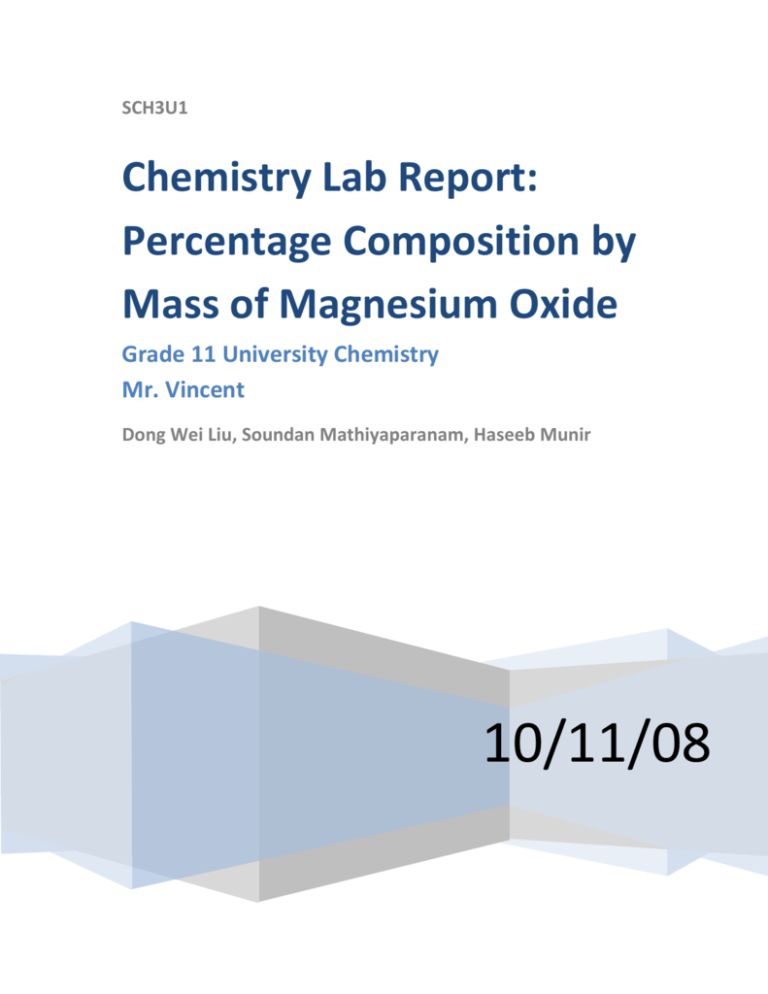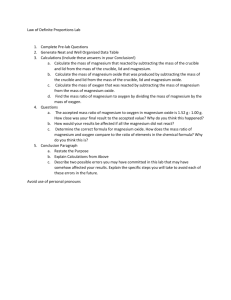Chemistry Lab: Percentage Composition by Mass of Magnesium Oxide
advertisement

SCH3U1 Chemistry Lab Report: Percentage Composition by Mass of Magnesium Oxide Grade 11 University Chemistry Mr. Vincent Dong Wei Liu, Soundan Mathiyaparanam, Haseeb Munir 10/11/08 Percentage Composition by Mass of Magnesium Oxide Page |1 Table of Contents 1) Introduction……………………………………….……………………………………….2 2) Materials……………………………………………………………………………………..2 3) Observations………………………………………………………………..……………..2 4) Conclusion………………………………………………………….……………………….3 5) Discussion……………………………………………………………………………….3 - 4 Analysis……………………………3 Evaluation…………….…..……..4 6) Sources of Error……………………………………………………….…………..……..5 © Soundan M., Dong Wei L., Haseeb M. Mr. Vincent 10/11/08 SCH3U1 Chemistry Lab Report Grade 11 University Chemistry Percentage Composition by Mass of Magnesium Oxide Page |2 Introduction: The law of definite proportions states that a specific compound always contains the same amount of elements in fixed proportions by mass. For example, the compound CO2 will always have the same ratio of carbon and oxygen when their mass is measured. In this experiment, this law will be tested. A product will be used to find out the percentage composition by mass of the two reactants with the known mass of one reactant. Question: What is the percentage composition by mass of magnesium oxide? Is this percentage constant? Prediction: Based on the law of definite proportions, the percentage composition of magnesium oxide should be 60.3% magnesium, and 39.7% oxygen. Equipment: Goggles Centigram or analytical balance 2-4 cm magnesium ribbon Steel Wool Porcelain crucible and lid Bunsen Burner Retort Stand Ring Stand and Clamp Clay Triangle Crucible Tongs Glass Stirring Rod Distilled Water Observation: Clean Crucible and lid Mass (g) Clean Crucible and lid, with magnesium ribbon 17.180 17.271 © Soundan M., Dong Wei L., Haseeb M. Mr. Vincent 10/11/08 SCH3U1 Crucible and lid, with powdered magnesium oxide 17.278 Crucible and lid and contents after the experiment 17.313 Chemistry Lab Report Grade 11 University Chemistry Percentage Composition by Mass of Magnesium Oxide Page |3 Conclusion: From looking at our results, the experiment was a failure. You can see that we were not able to prove the Law of Definite Proportions. The reason for this would be the high chance for errors, which we most certainly did encounter. See “Sources of Error” for more information. Discussion: Analysis A): Make a prediction based on the law of definite proportions. What should the percentage composition by mass of magnesium oxide be? Based on the law of definite proportions, the percentage composition of magnesium oxide should be 60.3% magnesium, and 39.7% oxygen. B): What evidence do you have that a chemical reaction took place? The fact that magnesium oxide was formed, which is a new substance, proved that a chemical reaction had taken place. C): Calculate the mass of oxygen that reacted with the magnesium. The magnesium ribbon was calculated to be 0.091(g) and the contents after the experiment was 17.313 -17.180 = 0.133(g) so, the oxygen should be 0.133 - 0.091 = 0.042(g). D): Use your evidence to calculate the percentage composition by mass of magnesium oxide. Magnesium = 0.091/0.133 = 0.684*100 68.4% Oxygen = 0.042/0.133 = 0.316*100 31.6% E): Based on the evidence (your results and those of your classmates), what are the answers to the questions. Yes, the law of definite proportions is valid, because most of the other groups that had not encountered as many errors as us had more accurate results closer to the predicted compositions according to the law. The rest had similar results to us which proves that their errors were similar to ours. Answer based on our results: With only our results, the percentage composition by mass of magnesium oxide is 68.4%magnesiu, 31.6% oxygen. And, the percentage is not constant as this is different from the law of definite proportions. © Soundan M., Dong Wei L., Haseeb M. Mr. Vincent 10/11/08 SCH3U1 Chemistry Lab Report Grade 11 University Chemistry Percentage Composition by Mass of Magnesium Oxide Page |4 Evaluation A): If some of the magnesium oxide had escaped from the crucible, would your percentage composition calculation of magnesium be too high or too low? Explain. If some of the magnesium oxide had escaped from the crucible, the percentage composition calculation of magnesium would be too high. This is because, when the magnesium oxide is lost as light, we would notice the percentage of magnesium to be quite larger. B): If the magnesium had reacted with some other component in the air, would your percentage composition calculation of magnesium be too high or too low? Explain Another component in the air that magnesium would react to is Nitrogen. However, if magnesium had reacted with some other component, the percentage composition would pretty much depend in the mass of the component that the magnesium had reacted with. If magnesium reacts with nitrogen and afterwards, when water is added to it, Mg3N2 would decompose to form MgO. So the percentage composition calculation of magnesium would practically be the same. C): The magnesium ribbon was polished to remove any white film on its surface before beginning the experiment. Explain why this is necessary. The white film on the surface of the magnesium was polished because it prevents reactions of magnesium and gas elements in the air. This was necessary because we wanted magnesium to react with oxygen and therefore had to remove the white film. D): Suggest a modification in the procedure to ensure that all of the magnesium completely reacts with oxygen A modification could be that the oxygen could be pumped into the container, instead of leaving it slightly open with the hope that oxygen will be the only thing that goes in. That could ensure the Mg reaction with O quite effectively. E): Evaluate your prediction. Based on the evidence obtained from several groups, is the law of definite proportions valid? Yes, the law of definite proportions is valid, because most of the other groups that had not encountered as many errors as us had more accurate results. The rest had similar results which proves that their errors were similar as well © Soundan M., Dong Wei L., Haseeb M. Mr. Vincent 10/11/08 SCH3U1 Chemistry Lab Report Grade 11 University Chemistry Percentage Composition by Mass of Magnesium Oxide Page |5 Sources of error: We predict that there is a 40% chance for error. You have to be very precautious while doing this experiment. Here are reasons/possible errors that could have been encountered: The magnesium oxide could have been lost through the crucible during the heating process. This could result in the loss of the product. To prevent this, the lid should be set slightly off-centre on the crucible so that only the air goes in. When the glass stirring rod was used to crush the magnesium, there is a high chance that the magnesium oxide could have been left on it before adding the water, resulting in the loss of product. To prevent this, the stirring rod should be held above the crucible and then pour the water slowly on to the end of the stirring rod so that the water would run down into the crucible while dragging the MgO from the stirring rod. Magnesium could have not reacted with oxygen completely. The crucible might be left dirty with other particles in it that could have made variations in the MgO reaction. The water could be contaminated. All water might not have evaporated. Magnesium having not been crushed completely into powder after reaction. Rushing through experiment because of lack of time. Chance of Problem with weighing scale. Crucible had extra weight due to extra contents that were unseen. © Soundan M., Dong Wei L., Haseeb M. Mr. Vincent 10/11/08 SCH3U1 Chemistry Lab Report Grade 11 University Chemistry






